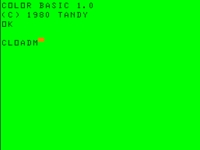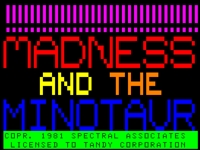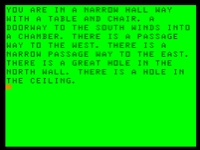Slot machines, so the theory goes, are addictive precisely because of the randomness of the payoff. It’s not simply the possibility of winning that draws players, but the hypnotic, chaotic patternlessness of winning and losing that sucks them in.
Videogames work this way too, sometimes. D.B. Weiss’s otherwise undistinguished book Lucky Wander Boy does have the germ of an idea in exploring the (fictional), eponymous arcade game, which was both exceedingly difficult and surrealist.
My own personal Lucky Wander Boy is a text adventure for the TRS-80 Color Computer called Madness and the Minotaur. To the best of my knowledge, no one has ever beaten the game. It’s not clear to me that it is actually possible. I’ve held on to a TRS-80 Color Computer solely to play this game. For years I’ve dragged a cassette around with a backup of the game on it, on the b-side of a tape which held Frank Zappa’s Joe’s Garage album. I could sing you the scratchy John Zorn song the accumulated bits make from the tape as they load, slowly, into memory.
I didn’t have a Color Computer in 1980, but my best friend, Billy, did. If Ultima and the Apple 2 make me think of Albert and Paul and eighth grade, the Color Computer makes me think of Billy and his Irish Setter, Sputnik, and the fireworks his parents let us set off — a firecracker, a moment’s distraction, looking back and time slows and expands as I see the red glowworm of lit fuse crawl into the paper, my face just a foot away, the report knocking me back in slow motion, high pitched ringing in my ears and the sky ash-gray over a green green lawn. Like a long-forgotten odor, memories of each of these little computers, these little bits of consumer electronics, activate different aspects of my nostalgia. Each time the perfume of nostalgia wells up, it clouds my vision, and I have to wrestle with a part of my emotional past and understand it before I can see these products for what they were, rather than getting lost in what they represent to me. Perhaps what they represent is more important than what they actually were. But, nonetheless, let’s talk about the game that, to me, epitomizes the Color Computer.
Madness and the Minotaur is a text adventure game. It is a brutal, unfair, senseless labyrinth which is amateurishly written and probably unwinnable. The parser is primitive and arbitrary. Object placement is semi-random (some objects are guaranteed to be on certain floors of the labyrinth). Some objects are protected by key-rules: for example, you can’t pick up the shield unless you’re holding some other object. In one game, that might be the dagger, in another, the sword. There’s never any explanation for these rules; they simply are. If you are holding the dagger, you can reach the shield. If you’re not, the shield is out of your reach. There’s a wandering Oracle whom you’ll meet occasionally, who will tell you the arbitrary rules. But sometimes he lies.
Part of the labyrinth — the first part — is the same from game to game, so the player is comforted by the sense of familiarity. Things go rapidly downhill from there. There are one-way doors, and secret doors. The obstacles in the game I hate the most, perhaps, are the pits that must be jumped even though you have no reason to suspect they’re there. With a different syntax each time — maybe here you’ll need to JUMP PIT, or here you might have to JUMP UP. Or JUMP POOL. or just JUMP. If you pick the wrong adjective the game will ask you JUMP WHAT?, as if the randomness of its syntax is your fault.
There are monsters, but most games don’t end with players getting killed by them. Usually, players will either lose the lamp (due to a random event) and die by falling into a pit. Or there will be a rock slide, trapping them in a room until they die of boredom (there are magic spells to blow away the rock slides, but they’re very hard to get, and usually the rock slides happen early in the game, long before you’ve gotten the spells.) Or players will wander in to the maze part of the map and then give up.
I’d never met anyone who had successfully mapped the maze. Every few years, I’d fire up the Color Computer (or, in more recent years, an emulator), play the game a bit, and then search the internet to see if anyone else knew anything about it. For the first few years of the early 90s, it seemed that no one had even heard of the game. Then, in 1995, I found a fan page that basically said “This game is really hard. Here are some hints, but I’ve never even come close to finishing it.” Another page cropped up the next year.
This year, I found a page by someone who has gotten further than anyone else I know. Through seemingly obsessive effort, he has cracked the puzzle of the maze, although he still hasn’t won the game. I never would have been able to figure out how this maze worked in a million years. Here’s how it is laid out (skip to the end of this article and download the game itself if you want to avoid spoilers):
The game itself takes place in 4 floors; you start on the top level. Each floor is an 8×8 grid. The bottom three rows of each floor are part of “the big maze”. In the big maze, every room has basically the same description (“You are in a maze of…”) and is connected to every other room above and below it (if you go down from the fourth floor, you’ll end up in the same cell on the first floor). The rooms also wrap east-west, but discontiguously: if you’re in the easternmost room of row 7, and you go east, you’ll end up in the westernmost room of row 8. Of course, just to make it even harder, there’s no indication to tell you you’ve “wrapped” to the next row. There’s no north-south wrapping. The southeasternmost room of each floor generally has no eastern exit.
There’s one and only one way to exit the big maze. You have to find the southeasternmost room on the “bottommost” floor. That room has an eastern exit, which if you take it leads to another, smaller maze (which can’t be distinguished by description, only by mapping it). Somewhere in that maze is a pit. If you jump the pit, you get outside.
“Cruel” doesn’t even begin to describe this game.
The guy who figured out the maze has done better than anyone else I know — he’s gotten 220 points out of a possible 240 (for comparison, the most I ever got was, perhaps, 30, which is about all you can hope for without figuring out the maze). He has no idea where the other 20 points could possibly come from.
The game was written by “Spectral Associates,” a company that usually put author credits on their games, but didn’t on this one. Who actually wrote it? What was he thinking? Did he ever play his own game through to the end? I will probably never find out. But I will always wonder. Madness and the Minotaur was not my first computer game obsession, nor my last, nor even my strongest, but it occupies a strange and special place in my soul. A little portion of my brain is twisted in a labyrinth of black on green uppercase letters, searching for systematic meaning and order where there is only an undertested game, and…a maze.
Additional Resources
- The most comprehensive spoiler/hint page on the net for Madness and the Mintoaur is maintained by btritico. I may not like his page design, but he understands more about the game than I do.
- Another fan page — the first one that I found, in 1995, is at figmentfly
- You can download an image of the cassette, suitable for use in an emulator, here. On the Mac, you probably want (or need) the MESS or AdvanceMess emulators. Those should work on PC as well, although I believe there are also standalone CoCo emulators for Windows that might be less overhead. Feel free to contact me if you’re having difficulty getting an emulator up and running, and I’ll do what I can to help.
- There’s actually a Java-based CoCo emulator which will let you load cassette files — this is probably your best bet to play the game on any platform.
- I thought that Lucky Wander Boy suffered from a lot of problems, not the least of which was that it devolved into psychotic melodrama in an attempt to give its topic more gravitas than it needed. But I’d be lying if I said I didn’t feel a shock of recognition a few times when reading it.








Sounds like the perfect accompaniment to House of Leaves.
Wow! I had a pirated version of this cassette in 1982 that would only load one out of two times; I never thought I’d find this game again. Now one can play it in the Java VM.
Thanks for your page!
OMG!!! I’m NOT the only person to be driven crazy by this fersghlugginer game!!! Now I know it wasn’t just me… the game IS a bitch.
Wow. What possessed me to come looking for sites, for this game ….. again, a few years later?
What possessed me to come looking for sites, for this game ….. again, a few years later?  Probably my days-old rekindled desire, to start learning how to program Text Adventure games, again.
Probably my days-old rekindled desire, to start learning how to program Text Adventure games, again. 
 And no – I’ve NEVER won it. Haha. Just NOW, I relearned that you CAN save it! Talk about major duh! I was using my Coco emulator, to do a memory dump, to ‘save’ my game. LOL!
And no – I’ve NEVER won it. Haha. Just NOW, I relearned that you CAN save it! Talk about major duh! I was using my Coco emulator, to do a memory dump, to ‘save’ my game. LOL! 

 (This text adv. software writing program, uses the same engine, that all the Infocom games ran on.
(This text adv. software writing program, uses the same engine, that all the Infocom games ran on. 
 )
)
Madness and The Minotaur, 23 years later, to this day – is STILL, my most fave text. adv. game, ever.
When I was a member of a MaTM USERs group (from Rainbow Mag.) in 1984 – I received full maps of the game – fully decoded (the maze). Still have them (though, in storage, in a differnt city.) Back then though – 1, of the 100 members group, HAD apparently solved the game.
Now – does ANYone know – how and where I can get the source code for the game? And IF, it’s written in 6809 Assembler, would anyone know of any software, that could translate THAT, into Basic, C, C++? I’d LOVE to rebuild this game, in Inform.
Anyhoo …. enough 1/2 awake babble. Time for sleep. |-) Zzzzzzz.
Thanks muchlee for posting this site! Great to see that there’ll still fans of this game out there.
Ryk
P.S. Text adventures – no graphic game, to me, can ever compare to them. I’m glad I came back to them, this week – to start learning how to program them, using Inform.
http://www.inform-fiction.org/
Was waxing nostalgic about the days of the green letters and black screen spent with my Tandy attmepting to get somewhere with Madness and stumbled on your page and the CoCo emulator on figmentfly. Had great fun playing this afternnon, but I STILL haven’t managed to win a point, after all these years. One of these days I will, now that I know where to go to play it!
I’m interested in making an entry for this game in the Mobygames database — and I’m interested in using your screen captures as part of it. Could I be granted permission to use them there? Please write back to let me know yea or nay.
Madnss is a great game. I am basically a computer idiot, don’t understand emmulators and all. Anyway looking to play again (Madness…) now on windows format. Myself and a dear deceased friend played the game for hours back in the ’80s. Had some maps hints and the like. Eventually we did kill the Minotaur and beat the game. We did spend inordinate amount of time doing so. Most I can remember is to always save the game. Each time the game is restarted where the items are, what you need for what spell, and what items are needed to kill which characters change, it appears to be completely random. The volcabulary is always the same, as are the rooms. Maps are required. You have to move rapidly through the mazes. Store all items you receive in one room, carry only what is needed. I recall we used the room you enter from the start room. Anyway I really like the game and would welcome any info on how I can find a source to be able to play on my pc windows operating system.
I just finished disassembling-and-commenting a cousin of M&M (Pyramid 2000). I couldn’t find any reports on the web of anyone actually winning M&M, so I have begun the dig into the code. You can follow my work here:
http://computerarcheology.com/madness.html
I did find this in the code already: you have to type SCORE to win. You can walk around all day having gathered all 220 points. But until you type SCORE after gathering all the points, you won’t get the “you win” sequence. Sneaky.
OK. I finished the disassembly and have a detailed write up at:
http://computerarcheology.com/madness.html
Now I’m off to use the info and actually win the game! (I was mistaken about the SCORE hint earlier. You win by just dropping all the treasures in the forrest.)
Chris! 27 years I wished for a disassembling of the code for Madness and The Minotaur! I haven’t any way to express the magnitude of my thanks to you for doing this!

THANK YOU!
Now I’m off to hopefully / eventually, have the game rebuilt to as close to the original as possible (including the 32 character screen emulation) in the Inform 7 (Interactive Fiction / text adventure) programming language.
WAY back in the day I managed to map the maze – you have to drop an object in each room and then run back and forth figuring out how it all connects. I’ve been looking for an emulator to play this again that allows me to save the game – without saving the game will be impossible, the lamp will be blown from your grasp or some cave-in will happen or whatever. I’m gonna win this mutha once and FOR ALL.